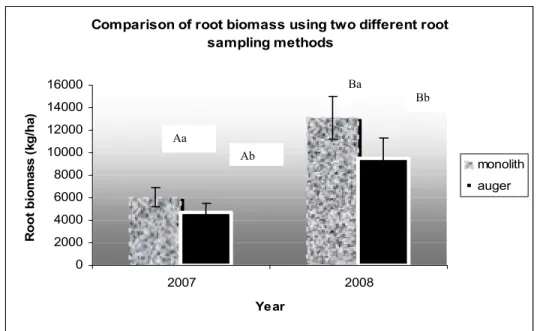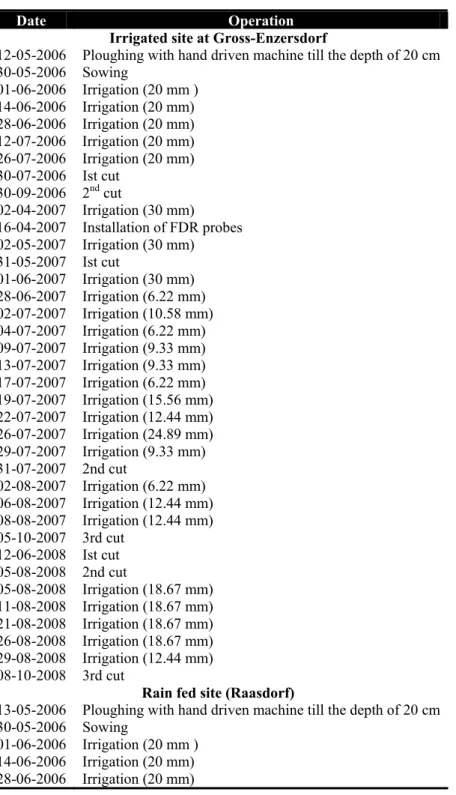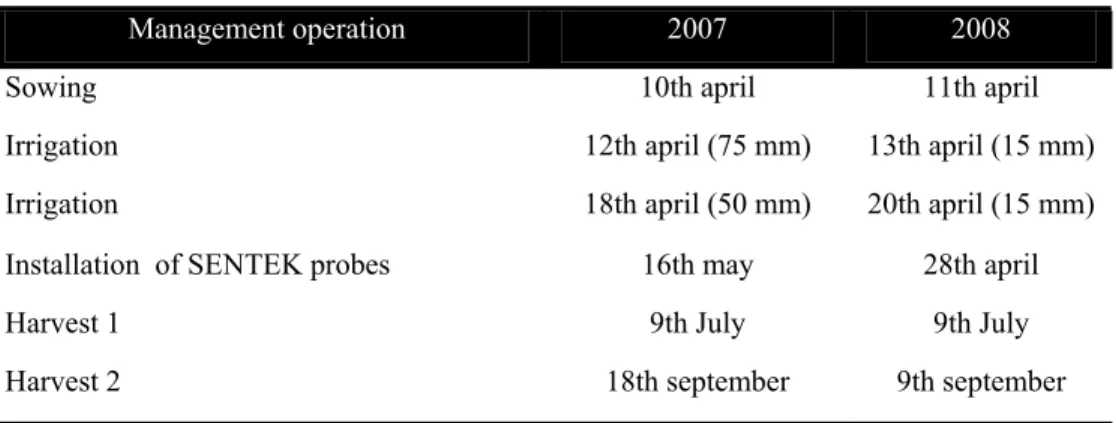The first set compares shoot and root dry matter yield and water use efficiency of three alfalfa varieties viz. The second set compares the effect of alfalfa utilization system on shoot and root dry matter yield, water use efficiency and biological nitrogen fixation.
Improving water use efficiency for sustainable agriculture
Root sampling and analysis in lucerne field trial
Evaluation of CropSyst for studying effect of mulching with lucerne
Problem description
The main nitrogen source in organic farming systems is nitrogen fixed by legumes (Loges et al., 2000). This biological nitrogen fixation (BNF) is the main source of nitrogen in organic farming systems (Pietsch et al., 2007).
Objectives
Field experiments with repeated water measurements will improve our understanding of the effect of alfalfa mulching. In addition, it will improve our understanding of the effect of mulching on yield, water relations and nitrogen fixation of alfalfa.
Improving water use efficiency for sustainable agriculture Abstract
- Introduction
- Definitions, concept and critical remarks on water use efficiency
- Methodological challenges
- Better agronomy
- Crop management
- Soil management
- Irrigation management
- Conclusions and challenges
Crop rotation can optimize water use efficiency by (i) increasing the number of crops grown per year, (ii) more effective use of available resources, and (iii) better phytosanitary conditions. A 25% increase in chickpea water use efficiency has been reported through nitrogen fertilizer application (Bahavar et al., 2009).

Introduction
The use of reliable methods for estimating root biomass is essential in organic farming systems. Calculations of root biomass are based on the percentage of "on" and "between" row area.
Materials and methods
For soil core samples, root biomass was calculated separately for both positions, on-row and between-rows using a correction factor for the percentage of area present on and between rows. For the calculation of root biomass from the monolith samples, an area percentage factor is not used, since the monolith area already includes roots present both in rows and between row positions.
Results and Discussion
Although the soil monolith provides relatively more reliable estimates of root biomass than the soil core, it is more destructive than the soil core. The soil monolith was not used to estimate root biomass in the alfalfa cultivar experiment (Chapter 3) as it was a small field experiment.

Comparison of performance of lucerne varieties under irrigated and
Materials and methods .1 Experimental set up
- Site description
- Determination of inorganic nitrogen content
- Determination of organic carbon contents
- Determination of soil texture and bulk density
- Determination of saturated hydraulic conductivity
- Determination of soil water retention characteristics
- Studies on above ground biomass and its components
- Carbon isotope discrimination
- Measurement of soil water content and water balance calculations
- Water use efficiency of productivity
- Statistical analysis
Irrigation was applied based on regular soil water content (SWC) monitoring using FDR probes (Frequency Domain Reflectometry, ML2x, UMS GmbH, Munich, Germany). The amount of irrigation water applied was calculated for 0-30 cm depth based on soil moisture content to field capacity. Soil samples were collected at both test locations to determine the inorganic nitrogen (N) content.
These replicates were selected based on the variation in soil texture determined by the finger testing method. Shoot-based carbon isotope discrimination (CID)(Δ) was determined in three main harvests from both locations in 2007–2008.

Results
- Physio-chemical properties of experimental sites
- Soil water content at field capacity and permanent wilting point
- Inorganic nitrogen content of experimental sites
- Biomass and its components
- Carbon isotope discrimination
- Root biomass, root length density and associated parameters
- Evapotranspiration of lucerne varieties
- Water use efficiency of productivity
Site-variety interactions were found to be non-significant for all major harvests in both years. Interactions between sites and cultivars were non-significant for all major harvests in both years. Interactions between sites and depths were nonsignificant for all major harvests in both years (Table 3.10).
Differences between varieties were found to be non-significant at all harvests in both years except final harvest in 2008. Differences between six alfalfa varieties at the rainfed site were found to be non-significant at all harvests in both years (Table 3.15).

Discussion
Differences between six varieties in a rain-fed location were not significant, except for the second harvest in 2008 (Table 3.17) (Table 21). Higher leaf to stem ratio values are usually observed in a rain-fed site compared to an irrigated site. Higher values of WUEp at the irrigated site compared to the rain-fed site are associated with higher SDMY.
Varieties tended to perform better under irrigated conditions compared to rainfed conditions in both study years. At the rainfed site NS-banat, Sitel and Niva appear to perform better and may be suitable choices for rainfed conditions due to their relatively higher yield and WUEp.
Introduction
Simulation models such as CropSyst (Stöckle et al., 2003) can be used to compare the effect of utilization system (no mulch versus mulch) on yield and soil water conservation. Initial alfalfa shoot dry matter yield data is required for mulch application using the model. To compare the effect of the utilization system (no mulch versus mulch) on alfalfa yield and its components under semi-arid conditions.
To test whether mulching increases nitrogen fixation and water use efficiency and lowers soil temperature. To generate alfalfa shoot dry matter yield datasets under different application systems for use with the simulation model, CropSyst.
Materials and methods
- Experimental details and site description
- Data recording on yield and its components
- Soil and root sampling
- Measurement of soil water content and calculation of water balance and water use efficiency of productivity
- Measurement of soil temperature
- Samples for isotopic analysis
- Estimation of biological nitrogen fixation
- Determination of soil texture, bulk density, soil water retention
- Statistical analysis
Soils are Calcaric Phaeozems (WRB, 1998) of fine alluvial sediments with a silty loam texture, organic carbon contents of 2.2% in the Ap horizon and a pHCaCl2 value of 7.6 (Pietsch et al., 2007). The chlorophyll content (mg m-2 leaves) was measured from 30 fully expanded leaves in the upper 20 cm of the canopy. Data from the second harvest in each year are presented in the results and discussion section.
Δ (‰) values were determined with an isotope ratio mass spectrometer (IRMS-Thermo Quest Finnigan DELTA plus) in the laboratory of the Department of Chemical Ecology and Ecosystem Research, University of Vienna, according to the procedures of Farquhar et al. The degree to which the 15N/14N ratio is reduced in the fixing plant (legume), relative to the non-fixing plant, can be used to estimate fixed N2 in the field.
Results
- Results of laboratory studies
- Effect of mulching on yield and its components
- Effect of utilization system on actual evapotranspiration of lucerne
- Effect of utilization system on soil temperature
- Effect of utilization system on water use efficiency
The RDMY in 0-60 cm of the soil profile under different alfalfa utilization systems in both years of the experiments is shown in figure 4.2. Biological nitrogen fixation: Interactions between treatments and years were found to be non-significant for total N and Ndfa yield. Data on yield and its components in different systems of alfalfa utilization are presented in Table 23 (see Appendix-1).
Mulching with lucerne was found to be effective in lowering soil temperature by 1-5 0C and differences between treatments were found to be significant. Differences between treatments and interactions between treatment and year were found non-significant for WUE of photosynthesis/CID.

Discussion
Besides the effect of rainfall, 2008 was more suitable for alfalfa production and the results of other experiments at the same site indicate higher yields of alfalfa varieties in 2008 compared to 2007 (Moghaddam, 2010). These findings are in line with those of Pietsch et al. 2007) who reported that the utilization system had no clear influence on the above and below ground dry matter yield. Mulching lowered soil temperature by 1-5 °C compared to no mulch in the current study.
Mulching had no significant effect on increasing above- and below-ground dry matter yield, WUE and BNF of alfalfa in this study. Because the alfalfa crop in the no-mulch treatment started regrowth simultaneously, thereby negating the minor effect of biomowing.
A comprehensive experimental study with modeling to investigate the
Materials and methods .1 Experimental data
- Brief model description
- Perennial crops
- Model parameterization
- Scenario Analysis
Very rare fine roots were found up to 1.9 m only for the alfalfa variety Mohajaren in the irrigated area. A full description of the model is given in the user's manual (Stöckle and Nelson, 1994), which has been updated (Stöckle and Nelson, 1996). In spring, production resumes when the opposite occurs (Ta > Fatigue for 7 consecutive days), starting on a date in spring. The model simulates LAI and biomass after rest and after logging.
Richard's equation-based finite difference model was used to describe water flows in the soil profile. Influence of plant characteristics on components of the water balance was calculated for the entire growing season for each year, and the values in the tables are for the growing season.

Results
- Experimental results
- Model results .1 Calibration
- Validation
The agreement between simulated and measured AGB is quite satisfactory for all three varieties at most of the sections. Results on agreement between simulated and measured cumulative AGB of alfalfa varieties are shown in Fig. Model on estimates the AGB of Mohajaren (Fig.5.9) presented. The indices of agreement between simulated and measured AGB seem quite reasonable for Sitel and Niva as RMSE is low, and CD and EF are close to 1.
The effect of different SLA values on the cumulative annual capillary rise was not pronounced, although it varied between years. The results regarding the impact of SLA on biomass and components of the water balance equation are presented in Table 5.10.

Discussion
Under water stress conditions, SLA and SLR can decrease (Lemaire et al., 2005; Erice et al., 2010), leading to a reduction in AGB accumulation. Sensitivity analysis regarding effect of root depth explains how model performance in terms of AGB accumulation and components of water balance can be affected by changing only one parameter related to roots (see table 5.9). The adequacy of the model to simulate AGB and profile SWC provided opportunity to analyze the impact of plant characteristics including MRD, SLA and SLR on AGB accumulation and components of water balance.
The analysis of the results from the scenarios on the effect of MRD on AGB shows that the value of 1.6 m seems to be quite satisfactory in terms of biomass accumulation in both years, since the increase of MRD above 1.6 m does not bring a significant increase in AGB accumulation (Table 5.9). The SLA value of 30 m2 kg-1 seems quite reasonable for the accumulation of AGB under the conditions of the experiment.

Evaluation of CropSyst for studying effect of mulching with lucerne
Introduction
Simulation model, CropSyst, (Stöckle et al., 2003) is a SPAC model which has biomass fate options where we can choose to harvest the biomass and specify a percentage of biomass to be left in the field as mulch or we can harvest and designate it for beneficial use. These capabilities make the model a suitable choice for comparing results on different alfalfa utilization systems (no mulch versus mulch). This study was designed to evaluate the effectiveness of CropSyst under different alfalfa utilization systems.
Materials and Methods .1 Experimental details
- Model parameterization and calibration
No site-specific calibration was performed and original water content values obtained from the data logger were used to calculate profile SWC for comparison with simulation results. Few selective parameters were subjected to sensitivity analysis to find their optimal value to obtain a good fit of measured and simulated above-ground biomass (AGB) for Sitel under non-stress conditions (it concerns irrigated sites in Chapters 3 and 5). Simulation scenarios for two different utilization systems were created separately each year to predict the behavior of the model to the utilization system (no mulch versus mulch).
According to the biomass fate option for the cutting file of the first harvest of each year, 95% of the cut biomass remained as a residue on the surface to perform the mulch treatment using the model. The optimal value for EF is 1, and if it is positive, it means that the model is a better predictor than the average of the measured values.

Results
- Comparison of experimental results with model results
Non-significant differences were observed among cultivars for shoot and root dry matter yield and water use efficiency. Seed yield and water use efficiency of canola (Brassica napus L.) as affected by high temperature stress and supplemental irrigation. 2009) Effectiveness of water cushion irrigation method on yield and water use efficiency of hot pepper (Capsicum annuum L.).
2003) Evapotranspiration, yield and water use efficiency of drip irrigated maize in the Bekaa Valley of Lebanon. Observations on the effect of seeding pattern on water use efficiency of durum wheat in semi-arid areas of Morocco.








